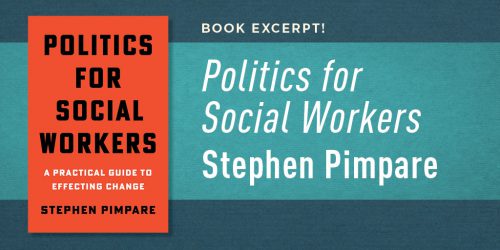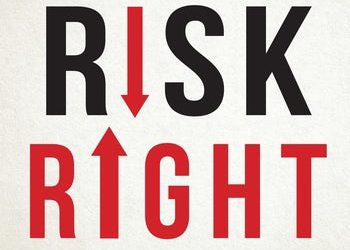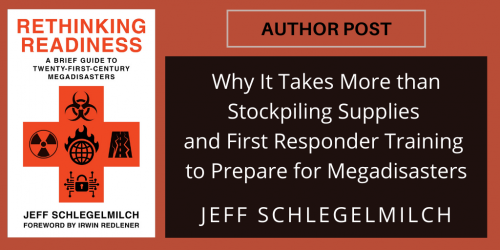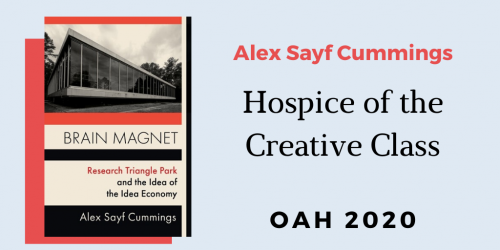Q&A: Natural Disaster Recovery Experts on Responding to COVID-19

COVID-19 has presented new challenges for leaders at all levels, forcing many to reconsider their emergency management processes. What are the impacts of the current public health crisis on disaster preparedness and community planning, and what will it take to build a more equitable and resilient future? We sat down with Laurie Johnson and Robert Olshansky, authors of the Lincoln Institute book After Great Disasters: An In-Depth Analysis of How Six Countries Managed Community Recovery and companion Policy Focus Report to discuss the pandemic and the path forward. Johnson, an internationally recognized urban planner specializing in disaster recovery and catastrophe risk management, has advised local governments and others following earthquakes, landslides, floods, hurricanes, and human-made disasters around the world. Olshansky is Professor Emeritus of Urban and Regional Planning at the University of Illinois at Urbana–Champaign and has published extensively on post-disaster recovery planning, policy for earthquake risks, hillside planning and landslide policy, and environmental impact assessment. Olshansky and Johnson also coauthored Clear as Mud: Planning for the Rebuilding of New Orleans, a book informed by their years on the ground after Hurricane Katrina.
• • • • • •
Emma Zehner: What lessons from disaster recovery are most relevant to this pandemic? How is this public health emergency different from natural disasters you have dealt with in the past?
Robert Olshansky: With many disasters, we think about external factors, but the way this disaster manifests itself is in people. The threat, instead of a hurricane or earthquake, is every person we encounter, which sets up a different dynamic. The other unique aspect is the time delay and the exponential nature of the spread. These are counter to our normal cognitive processes. Masks seem to reduce the exponential factor, but the time delay is still there. So, yes, we have the ability to control things and in principal have the ability to change the trajectory of the disaster, but some of that is an illusion because the situation is so unusual.
Laurie Johnson: Yes, time is one of the four factors that governments can control. The others are money, information, and collaboration. This case is slightly different. With sudden onset disasters like earthquakes, you come to the disaster scene and begin to act. Right now, we can actually act while the pandemic disaster is unfolding and try to control how impactful it will be. This is also unusual because it is impacting all of the United States and most of the world at the same time. Historically, disaster management in the United States and many other countries has been built on the concept of mutual aid. We don’t have all of the fire trucks to fight all fires in California, so we rely on supplies from elsewhere. In the case of emergency management in the pandemic, we haven’t been as able to use these mutual aid principles. In every state and every city, supply chains have been impacted.
This has called for a different kind of collaboration. Most of the needed action is actually inaction, social distancing, which is counter to the idea of collaborative governance in the sense of empowering people to rebuild. Instead we are trying to empower people to do nothing, which is hard for leaders to get their head around.
It has also been interesting to note how public officials have defined essential services. To flatten the curve and keep people sustained, we had to consider and maintain a wider set of services than what we normally think about for natural disasters, in which essential services focuses primarily on mass care and shelter, water, and other basic infrastructure. In the pandemic, essential also included access (even if limited) to exercise and outdoor recreation, farmers’ markets and restaurant take-out services, for example.
EZ: To what extent has the pandemic prompted a questioning of standard disaster preparedness and management practices, especially spatial/territorial ones?
LJ: This pandemic has underscored the idea of local primacy in disasters and the importance of leadership at the local level. California is depending on county and city public health officials and others to really make things happen. I think it will be the same in terms of recovery. The civil protests have also pushed local leaders on how limited resources should be reallocated at the local level. So the pandemic has raised some good questions about the mutual aid management model, and reinforced the need for local primacy.
RO: It has become clear that the model of local primacy with resources from above is really the way that we need to do it. Now what is missing is a lot of the resources from above. One of those resources is technical guidance, which is the role that the CDC should play. Others include federal coordination, communication, funding to make social distancing feasible, funding to ensure that economic impacts are equitable, regulatory actions to scale up testing, and policy changes to spur production of needed supplies.
LJ: Also, during this pandemic, there is a whole structure of public health management that is not typically as dominant in natural disaster management. You have different leaders: the National Institutes of Health and the CDC, and state and local public health departments. On top of that, you have political leaders setting up their own task forces. It is definitely not as lean and efficient as when you have clear lines of authority through the emergency declaration process, but I think that a ton of learning has occurred.
EZ: Has the response to the pandemic provided new tools and ways of thinking for disaster planning? What responses do you point to as examples?
LJ: It was an aha moment for me to realize that we can be so much more deliberate in mitigating the impacts while we are in disasters that unfold with time (even wildfires and hurricanes in which the disaster event can last several days). We typically talk about resilience in terms of engineering, such as building barriers for floods, and adaptation. Those both typically happen either before disaster strikes or during the recovery stage. We don’t talk as much about resilience during the event. The decisions we make during the crisis can really affect our recovery trajectories differently. The same is true of wildfires and hurricanes, even though the event timeframe is more limited. Mass evacuation in real time can protect lives and also allow first responders to focus on managing the hazard, like firefighting, instead of evacuating people during the disaster. The evacuation process can really help set the recovery up. As we note in After Great Disasters, in New Orleans following Hurricane Katrina, people were evacuated all over the country, but there are things we don’t really know: How many got back and when? How many were able to establish productive and happy roots elsewhere? I now see that we do have more ways to design a good recovery in real-time with the decisions and actions we take as the disaster is unfolding. Another example is sea level rise, which has a slow onset with sudden shocks in the form of storms. We actually have ways we can mitigate the impacts of sea level rise so that those sudden shocks of storms aren’t as impactful.
RO: The pandemic has reinforced a lot of things for us, but it has also stretched our thinking a bit. It is hard to say we are doing well, but in some ways we have done a lot—such as the initial shutdown that saved our healthcare system from collapse, federal funding to lessen economic impacts, growing capabilities for testing and contact tracing, and unprecedented development of treatments and vaccines–and I think this can increase our self-confidence that we have the capacity to deal with huge events like this in the future.
LJ: In terms of notable responses, the response where I live in Marin County (California) has been very good even with some major challenges and setbacks. The county public health officials produce a video nearly every day that walks you through the decisions the county is making. Their data provides a lot of demographic and geographic details and regularly updated progress indicators give them a dashboard of information to use in determining when to back off with the next [phase of] opening. The whole process has been pretty transparent and helped people to better understand what the tradeoffs and risks are.
New Zealand, one of the countries we studied in our book, has also been very transparent. People understood where they were with that system. Their response has also been led by the national health officials and not by the formal emergency management structure. They defined different alert levels right away and set a framework of guidance and restrictions for people to follow before moving to the next level. There was clear communication from national leaders and health officials daily and restrictions on movement were strictly enforced. Perhaps it’s easier for a country that size. Nonetheless, I do believe we have much to learn from their and many other countries’ approaches.
EZ: What could we be doing better?
RO: Some of our favorite governance models are various kinds of councils and committees that were set up after these large disasters. Part of what we are missing now is transparency, communication, and explanation. Counties in the San Francisco Bay Area, for example, all have dashboards of key pandemic indicators. Now they need to address how they are making policy decisions based on the data. I would like to see highly visible, explicitly defined councils at state and regional levels, so it is clear they have representation from all of the different stakeholders, are carefully listening to their views, and are making well-reasoned decisions based on multiple tradeoffs.
EZ: As we begin the COVID recovery, what can planning directors do to prepare for the next pandemic?
LJ: I am starting work on a local general plan update process now, and I think one of the things everyone has been rushing to deal with is how to work in a digital environment. How do you do both the day-to-day planning processes and the long-term planning, both of which need to involve the community? There are also big issues around equity that have been laid bare by the pandemic and we, as planners, need to understand which parts of our communities are successfully using online meeting platforms and other civic engagement tools and which are not because they don’t have access to smartphones or broadband. This is a good experience to help us strengthen and develop the tools that we need to do planning in a more expedited, online way. We are finding new efficiencies and it helps us in thinking about how we can streamline bureaucracy after disasters.
I do think some of our ongoing resilience work before the pandemic to protect against hurricanes, earthquakes, and other natural disasters is actually benefiting us right now. We have this pretty stable infrastructure that is supporting us in spite of all the demands that are being placed on the grid and on the internet in particular.
RO: Planners are very good at stakeholder involvement. In the pandemic, we need even more inclusive systems of broader stakeholder involvement, using various means of communication. We need those all the time after every disaster. Right now, I am able to attend a lot of meetings that I couldn’t attend before. We can use some of these tools that we have developed to expand the ability of a broader variety of stakeholders to communicate after all disasters. In the pandemic, all of these things have worked relatively well. In the case of an earthquake or hurricane, though, we expect to have physical infrastructure damage that can disrupt communication systems, so we need to continue to prepare to use multiple communication modes. As a result of this pandemic, we also appreciate even more the need to stay connected, and we should make sure our communications systems are going to be able to survive the earthquake and the hurricane as well.
LJ: I think planners are capable of seeing spatially and seeing systems: we are taught to think holistically. I would appeal to planners, as things come back online, to think about some of the problems that we had before this happened (congestion, traffic, etc.) and what policies we can put in place that will reduce some of those negative factors in our communities before the next disaster—but still not erode the economic and social vitality of our communities. To some extent, the civil protests are raising these questions. We don’t want to come back online without addressing the social injustice that we had long before the disaster. What did we learn during this pandemic that can be useful to this conversation? As planners, we are always studying the daily rates of this and the daily uptake of that, and we need to be providing that kind of information to the pandemic response and reopening conversations. How can we come back but reduce some of these negative daily things we know exist in our communities?







